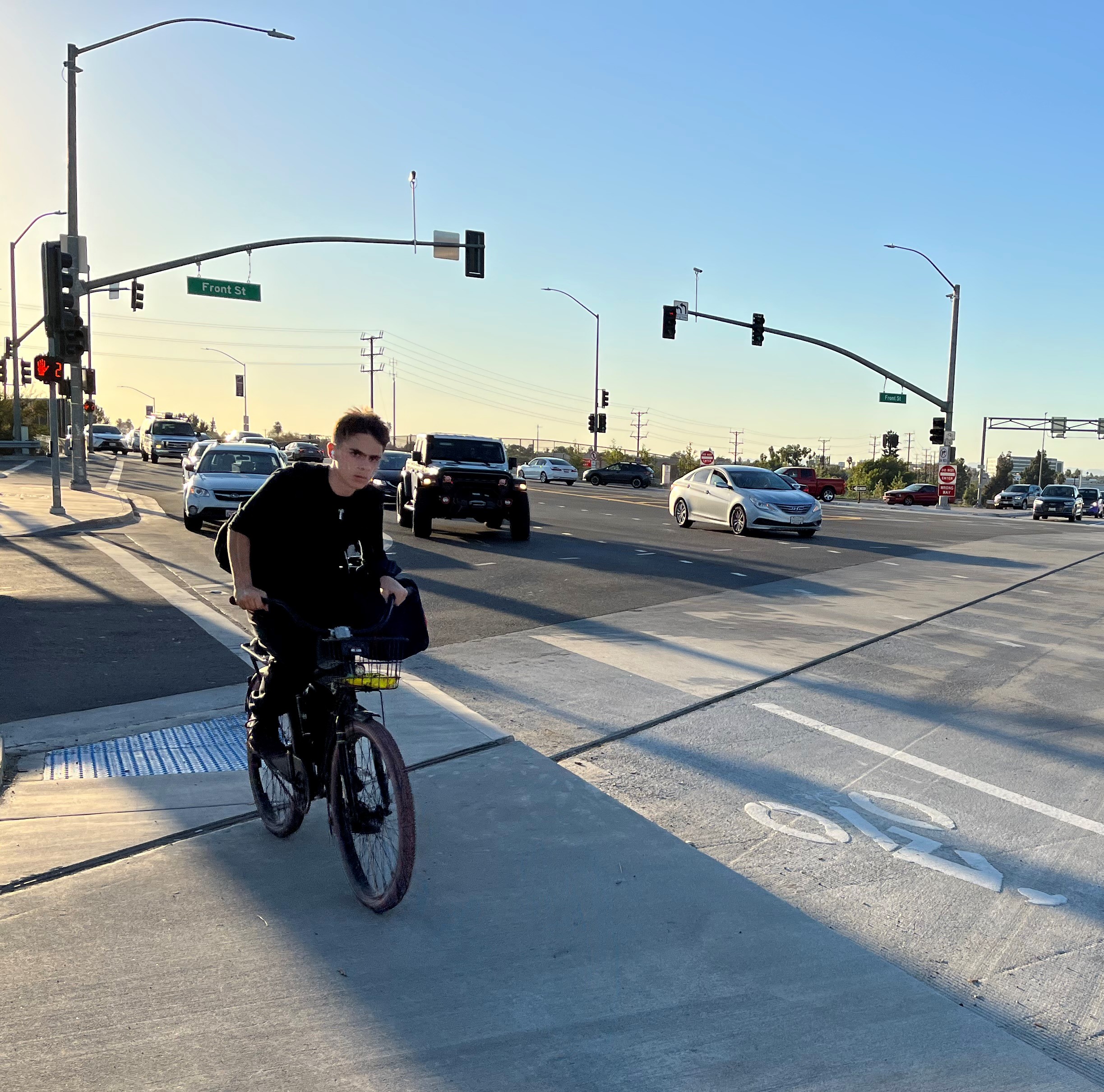
In order to improve safety on the recently rebuilt Burbank Boulevard Bridge, Caltrans and Metro are adding protected bike lanes and green pavement, and retooling signal timing. The upgrades are anticipated to be installed by December.
As part of their $1.3+ billion 5 Freeway widening project, Caltrans and Metro recently demolished and rebuilt the Burbank Boulevard bridge. The new bridge opened to traffic in November 2021. The former seven lane bridge is now ten lanes wide. The new bridge has two new unprotected bike lanes. The bridge's north sidewalk was eliminated (problematic, but that's another story), and the south sidewalk was widened.
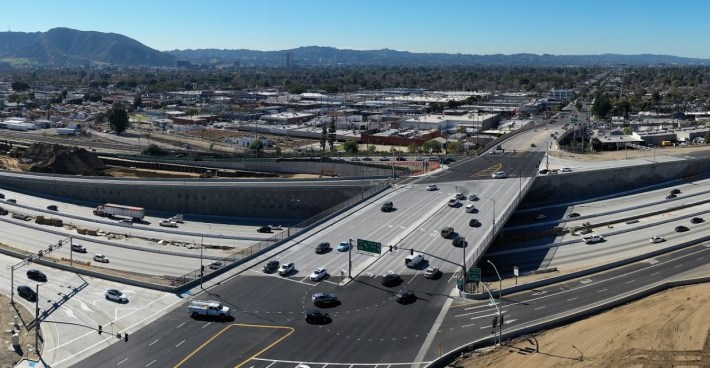
It is a complex bridge that spans the widened 5 Freeway, railroad tracks, and two channels of the Burbank Western Wash. Additional complications arise from an added intersection: between the tracks and the freeway, in the middle of the bridge, Burbank Boulevard intersects Front Street, adding a fifth ramp to four on- and off-ramps for the 5 Freeway. (On Front Street, the city has plans to add a protected bikeway to connect cyclists to the Downtown Burbank Metrolink Station.)
Road users experience this part of Burbank Boulevard as one big long bridge, but jurisdictionally it is two structures. West of Front Street, the bridge belongs to the city of Burbank. East of Front, it belongs to Caltrans. Only Caltrans's portion was rebuilt.
Soon after the new bridge opened, as reported by the Burbank Leader, cyclists expressed concerns that Caltrans' new bike lanes were inadequate and that the bridge was unsafe for cycling. Unprotected bike lanes (on only Caltrans' half of the bridge) conflict with multiple turn lanes funneling car traffic on freeway ramps.
Streetsblog visited the bridge during afternoon rush hour last week, and observed the current bridge congested by heavy car traffic. Only a small volume of people on bike and foot were on the bridge, apparently having gotten the message that it wasn't really rebuilt with them in mind. Eastbound cyclists there were using the sidewalk, not the bike lane.
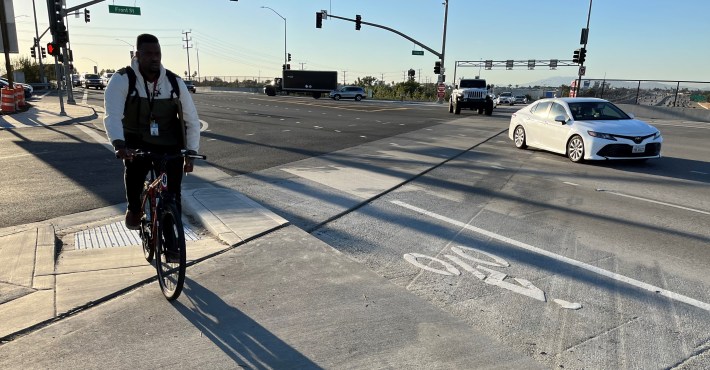
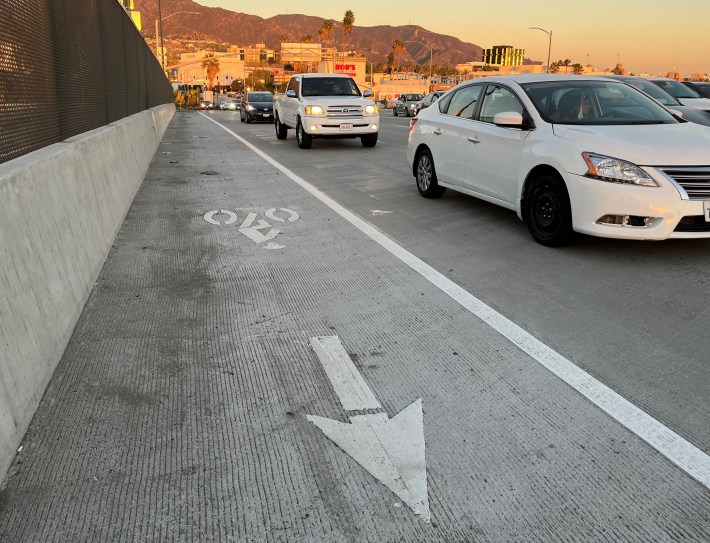
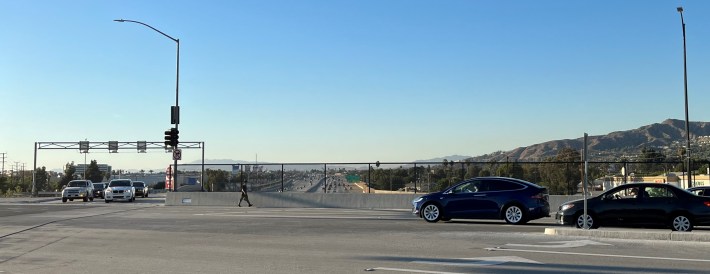

Per the Leader, the deficiencies were attributed to the difficulty of Caltrans shifting from a bridge design that was approved around 2010.
I am happy that my office was able to get the @BurbankCA and @CaltransDist7 together to address the lack of safety for active transportation users on the brand new Burbank Blvd Bridge. In projects big and small, we need to design + build with the safety of all users in mind. pic.twitter.com/tVtbOppgGh
— Laura Friedman (@LauraFriedmanCA) May 16, 2022
The city and Caltrans acknowledged cyclist concerns, and, in a process facilitated by State Assemblymember Laura Friedman, set out to redesign the bridge.
In a recent project update for the Metro board, Caltrans noted that a change order for the Burbank Boulevard Bridge "bike lane enhancements" was expected to be implemented by the end of the calendar year.
In an email, Caltrans District 7 Public Information Officer Michael Comeaux offered more specifics on the bikeway improvements:
We are curb protecting the eastbound bike lane at the point of heaviest conflict – between Front Street and the Southbound I-5 on-ramp – and in the rest of the Caltrans Burbank Bridge Project area we are adding another stripe to buffer the bike lanes and green paint at conflict points; in addition, we are phasing the signal timing at Front Street to let cyclists cross the Southbound I-5 on-ramp at a time when cars are not on the ramp.
The green paint at conflict points will be added within the limits of the Caltrans Burbank Bridge Project – as far east as San Fernando Boulevard and as far west as Front Street. The bridge area west of Front Street is the City of Burbank’s jurisdiction, and the City plans to do a feasibility study of that area to determine what it would take to add protected bike lanes there.
Comeaux stated the bikeway upgrades are expected to be completed by the end of December, but that the schedule is subject to weather and operational issues.
It is disappointing that the city of Burbank won't be improving the west side of the bridge at the same time as Caltrans improves the east side. Caltrans and Metro are spending tens of millions of dollars for off-freeway improvements in Burbank, as part of the widening project. On the eastbound side, adding at a quick-build inexpensive painted bike lane appears easy - while the city works on a feasibility study for a higher quality solution. (The westbound side is more difficult as a bike lane there would conflict with two right-turn only lanes for drivers.)

It is great news that Caltrans is moving fairly quickly to remedy the dangerous conditions on their side of the bridge. The curb-protected bike lane and new signal timing should go a long way to making the bridge safer and more conducive to bicycling. It won't be heaven, or Amsterdam, or even Davis. The bridge will still have heavy car traffic (and a hill) but at least, signal timing will reduce conflict, paint will make drivers more aware of where cyclists are, and the curb will help protect cyclists from errant distracted drivers.
The improvements also represent an important precedent.
In an email to SBLA, Assemblymember Friedman noted that, “This change order with the Burbank Blvd. Bridge/I-5 Bridge shows that we can evolve, that our agencies and general public are increasingly forward thinking. And that gives me hope that our processes can and, in these instances especially, are shifting gears in real-time, in a positive direction that centers sustainability and our collective safety.”
In recent years, Caltrans and Metro adopted Complete Streets policies that commit the agency projects to better accommodating the needs of pedestrians, cyclists, and transit riders. But many Metro and Caltrans freeway projects have been "in the pipeline" for so many years, that they are perceived as being at too late a point for making changes to better serve active transportation. Plans for the Burbank Boulevard Bridge were finalized around 2010; the project's groundbreaking took place in 2014. And then, when safety concerns became clear nine years into construction, Caltrans and Metro didn't just say "it's too late now" - but, working with the city of Burbank and Assemblymember Friedman, they recognized the safety need, and upgraded their long-approved designs.
Caltrans and Metro have lots of L.A. County freeway widening projects under construction, and many more planned. Highway project proponents sometimes scoff at the prospect of including bike/pedestrian/transit components in these projects, because, on freeways, nobody bikes/walks and few take transit. But pretty much all of these freeway projects interface with local streets - at bridges, undercrossings, on- and off-ramps. For decades these projects have degraded local conditions for bicycling and walking. The Burbank Boulevard improvements show that this need not be the case in the future.
Luckily, in the context of billion-dollar highway widenings, adding bike and walk components are fairly cheap - and even cheaper when planned while projects are in the pipeline instead of during construction. Streetsblog doesn't have a cost estimate for the Burbank change order improvements, but they appear to be somewhere around five-to-twenty thousand dollars. It is a change order (ie: a cost overrun), but the cost is likely well within the built-in contingency for a $1.3 billion project. It just doesn't cost all that much to incorporate basic bike infrastructure.
